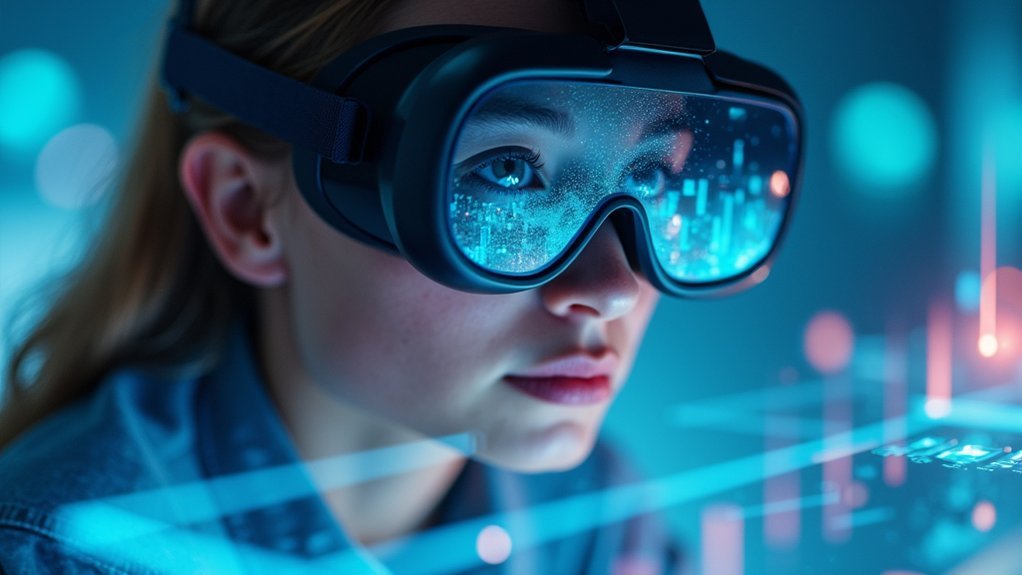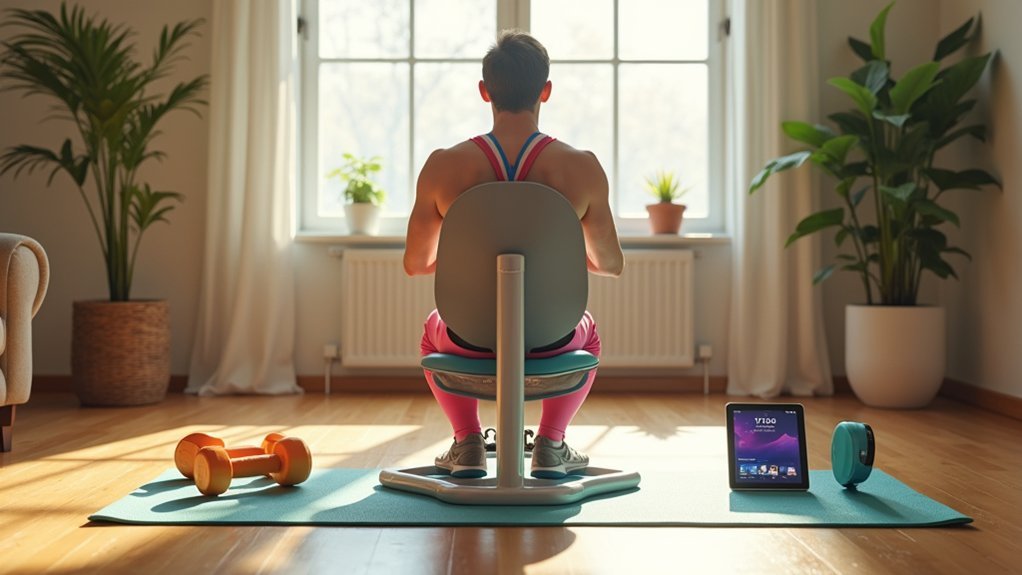Eye tracking in immersive displays measures where you’re looking, using infrared sensors that capture corneal reflections to determine gaze direction. This technology enables intuitive interactions through your natural eye movements while powering foveated rendering, which focuses processing power on what you’re directly viewing. You’ll experience better performance, extended battery life, and more intuitive interfaces in VR/AR headsets. Discover how this technology is transforming everything from gaming to healthcare in the modern immersive landscape.
The Science Behind Gaze Detection in VR

While traditional computer interactions rely on explicit commands through controllers or keyboards, VR eye tracking represents a fundamental shift toward intuitive, gaze-based computing. This technology works by using infrared sensors that emit light toward your eyes, capturing reflections from your cornea and pupil.
In VR, the display’s proximity to your eyes creates unique challenges for accurate gaze detection, as your vergence data is incomplete. To overcome this, systems combine your eye direction with virtual object depth cues.
VR eye tracking resolves depth perception challenges by merging directional gaze data with virtual spatial information.
Sophisticated algorithms process this information in real-time, interpreting your gaze direction, eye movements, and even pupil dilation. Some advanced systems like Neon now offer calibration-free tracking, eliminating setup procedures while maintaining accuracy.
This science enables interfaces that respond to where you’re looking, not just what you’re touching. The technology ultimately creates foveated rendering capabilities that significantly reduce computational demands by focusing processing power on what users are actively viewing.
How Eye Tracking Enhances Immersive Rendering
You’ll experience dramatic performance improvements through foveated rendering, which concentrates detail exactly where your eyes focus while reducing resolution in your peripheral vision.
This eye-tracking technology enables dynamic depth adjustment, automatically sharpening objects at your current focal point while naturally blurring distant elements.
Your immersive experience becomes more realistic and comfortable as the system continuously adapts rendering quality based on your gaze patterns, mimicking how human vision naturally works. This approach significantly reduces computing power needed while maintaining high-quality visuals in the areas that matter most.
Subheading Discussion Points
When implemented effectively, eye tracking transforms immersive displays by enabling foveated rendering—a technique that prioritizes graphical resources where your eyes are focused.
This smart allocation of processing power creates a more efficient VR experience while maintaining visual quality where it matters most. However, the effectiveness depends on overcoming tracking errors that can significantly degrade the user experience when not properly addressed.
You’ll notice several key benefits with eye tracking-enhanced rendering:
- Higher frame rates and smoother performance as your system dedicates resources only to what you’re actually looking at
- Extended battery life in standalone headsets due to reduced computational demands
- Sharper visuals in your focal area while maintaining an immersive peripheral experience
- Reduced motion sickness from more responsive displays that better match your natural visual processing
These optimizations work behind the scenes, creating a more comfortable and realistic virtual experience without sacrificing performance.
Foveated Rendering Efficiency
At the core of modern immersive display optimization lies foveated rendering, a technique that mirrors your visual system’s natural functioning. By tracking where you’re looking, VR headsets can render high-resolution graphics only where your eyes focus—the foveal region—while reducing detail in peripheral areas you can’t perceive clearly anyway. High-end devices like the Meta Quest Pro and PlayStation VR 2 utilize this technology to deliver superior visual experiences.
| Area | Resolution | GPU Load | Perceptible Difference |
|---|---|---|---|
| Foveal | High | Intensive | None (crystal clear) |
| Near-peripheral | Medium | Moderate | Minimal |
| Mid-peripheral | Low | Light | Negligible |
| Far-peripheral | Very Low | Minimal | Unnoticeable |
This selective rendering approach dramatically reduces processing requirements, enabling higher frame rates, longer battery life, and cooler-running devices. The computational savings can instead enhance visual elements in your direct line of sight, creating more immersive experiences without requiring top-tier hardware.
Dynamic Depth Adjustment
Perhaps the most profound challenge in virtual reality remains the vergence-accommodation conflict, where your eyes struggle between where they converge (vergence) and where they need to focus (accommodation).
This mismatch causes discomfort during extended VR sessions. Eye tracking enables varifocal displays that dynamically adjust focal depth to match your natural vision.
When you gaze at virtual objects, the system:
- Tracks your exact point of focus in real-time
- Calculates where your eyes’ sight lines intersect
- Physically adjusts the display’s position relative to the lenses
- Creates the correct focal depth that matches your natural accommodation
This technology greatly reduces visual fatigue while allowing you to focus on objects at varying distances, considerably enhancing immersion and making extended VR sessions more comfortable and natural. The integration of foveated rendering saves computational resources by focusing high-resolution rendering only where your eyes are looking.
Applications of Gaze-Based Interaction in Virtual Reality
You’ll find gaze-based interaction transforming VR experiences through intuitive selection mechanics that let you interact with objects simply by looking at them.
Your gaze can direct narrative flow in interactive storytelling, allowing you to choose different paths or trigger events based on where you focus your attention.
These natural interaction methods create a more immersive experience by reducing the cognitive load associated with traditional controllers and matching how you naturally explore environments. Advanced systems can now predict user interaction intent, helping to alleviate fatigue from prolonged VR usage while enabling more responsive interfaces.
Applications of Gaze-Based Interaction in Virtual Reality
Gaze-based interaction has emerged as a transformative technology in virtual reality environments, offering users intuitive ways to engage with digital content through their eye movements alone. This natural form of interaction enhances immersion while reducing physical fatigue through hands-free control of virtual elements.
In practical applications, you’ll find gaze-based interaction across several domains:
- Interactive storytelling where your eye movements influence narrative branching, creating personalized experiences that adapt to your focus.
- Intention recognition systems that predict your actions by analyzing fixations and saccades, making interactions more efficient.
- Depth-based interfaces allowing you to navigate layered UIs simply by adjusting your visual focus.
- Enhanced immersion through intuitive object selection that mimics how you naturally interact with your physical environment.
Research shows users prefer interaction methods that complement the aesthetic qualities of virtual experiences, with texture change methods receiving particularly positive feedback in storytelling applications.
Intuitive Selection Mechanics
Within the expanding landscape of gaze-based interaction, selection mechanics represent one of the most fundamental and transformative applications in virtual reality environments. By tracking your eye movements, these systems allow you to select objects simply by looking at them, drastically reducing the manual inputs required.
Techniques like EyeSQUAD have demonstrated remarkable improvements in accuracy, with error rates dropping from 17.4% to just 6.2% in testing. This method combines eye tracking with progressive refinement to stabilize your point-of-regard, proving more precise than ray-casting for small targets. One significant challenge remains the Midas Touch problem where uncertainty exists in determining when to activate objects through gaze alone.
While not quite matching SQUAD’s accuracy, the intuitive nature of eye-based selection offers significant advantages. Consumer-grade eye tracking devices now achieve performance comparable to manual controls, making this technology ready for mainstream adoption in your VR experiences.
Gaze-Directed Narrative Control
As virtual storytelling evolves, eye tracking has emerged as a powerful tool for narrative control in immersive environments. You’ll experience less fatigue and more intuitive interaction through techniques like Dwell Snap, Gaze Gain, and Gaze Pursuit that enable 360-degree viewport control using only your eyes.
These techniques enhance your storytelling experience in several ways:
- Dwell Snap rotates your viewport in discrete steps based on where you look.
- Gaze Gain amplifies viewport rotation proportionally to your gaze angle.
- Gaze Pursuit smoothly aligns the central viewport with your gaze targets.
- Visual elements like cartoon-style agents can attract longer gaze durations than realistic ones.
Interestingly, while visual elements markedly impact your gaze behavior, spatial audio conditions don’t substantially affect how you interact with gaze-directed narratives. The effectiveness of these techniques is supported by studies showing that virtual reality provides a controlled environment that maintains ecological validity while allowing precise measurement of eye movements.
Key Performance Metrics in Eye Tracking Systems
Performance measurement forms the foundation of effective eye tracking research and implementation. When evaluating eye tracking systems, you’ll need to focus on specific metrics that determine accuracy and user experience quality.
| Metric | Why It Matters |
|---|---|
| Sampling Rate | Higher rates (250+ Hz) capture micro-saccades and rapid eye movements |
| Fixation Duration | Longer durations indicate deeper cognitive processing of visual elements |
| Time to First Fixation | Reveals how quickly elements attract attention in your immersive display |
| Gaze Revisits | Shows which elements require multiple views, potentially indicating confusion |
Heat maps and scanpath visualizations help you interpret these metrics efficiently. By analyzing fixation patterns and saccade movements systematically, you’ll understand how users process information in immersive environments and optimize interfaces accordingly. Understanding the role of smooth pursuit is crucial when designing displays with moving elements, as it impacts how users track motion in immersive experiences.
Types of Eye Tracking Hardware for Immersive Environments
Selecting the right eye tracking hardware greatly impacts your immersive experience implementation. For truly immersive environments, you’ll need devices that balance precision with user freedom.
The marriage of technology precision and user freedom defines successful immersive experiences—choose your eye tracking hardware accordingly.
- Head-mounted trackers allow natural movement while maintaining accurate gaze tracking—ideal for VR applications where physical mobility enhances immersion.
- Embedded trackers integrate directly into XR headsets, creating a seamless experience without additional hardware attachments.
- Remote trackers work well for large-screen immersive displays where users need to maintain distance from the tracking equipment.
- Screen-based systems offer high precision for research-focused immersive environments where controlled conditions are essential.
Each hardware type employs similar core technologies—near-infrared illumination, specialized cameras, and sophisticated gaze mapping algorithms—but differs in form factor and application suitability. Using foveated rendering in these systems can significantly optimize processing power by reducing graphic quality in peripheral vision areas while maintaining high resolution where users are looking.
Overcoming Technical Challenges in Real-Time Gaze Tracking
Despite significant advances in eye tracking technology, implementing reliable real-time gaze tracking for immersive displays presents several formidable challenges.
Accurate calibration is essential but depends on stable head position and consistent lighting—conditions that aren’t guaranteed in dynamic VR environments.
You’ll encounter occlusion problems when your eyelashes, blinks, or glasses interrupt the system’s line-of-sight to critical eye features. These interruptions cause data loss or tracking errors that can break immersion. Reflective surfaces like glasses or makeup can create additional bright spots that confuse tracking algorithms and compromise accuracy.
Computational performance creates another bottleneck. Real-time tracking requires processing speeds above 30Hz, but more accurate 3D eye models and neural networks demand significant processing power.
Modern systems must balance accuracy and latency while adapting to diverse users and changing environmental conditions—from variable lighting to different eye physiologies.
Future Innovations: Where Eye Tracking Technology Is Headed
As immersive display technologies continue to evolve, eye tracking stands at the precipice of revolutionary advancement.
You’ll soon experience unprecedented accuracy with new 3D imaging techniques like deflectometry, which can capture over 40,000 surface points from a single image—dramatically improving gaze estimation precision.
The future of eye tracking includes:
- Integration as a core component in AR/VR headsets, creating environments that naturally respond to your gaze
- AI-powered assistive technologies like EyeControl and Project Iris, making digital interactions more accessible for people with disabilities
- Advanced healthcare applications that enable early detection of neurological disorders through visual attention patterns
- Enhanced immersive experiences with personalized content delivery based on your attention and preferences
These innovations will transform how you interact with digital worlds, making experiences more intuitive and responsive. Recent research has achieved tracking accuracy between 0.46 and 0.97 degrees with human subjects, with plans to reach even greater precision in commercial applications.
Frequently Asked Questions
How Does Eye Tracking Affect Battery Life in Portable VR Headsets?
Eye tracking extends your VR headset’s battery life by using dynamic foveated rendering, which reduces power consumption by focusing resources where you’re looking. You’ll gain up to 10% more battery through these rendering optimizations.
Can Eye Tracking Help Reduce Motion Sickness in Immersive Experiences?
Yes, eye tracking can help reduce your motion sickness by monitoring your gaze patterns in real-time. It allows systems to adjust visuals based on where you’re looking, creating a more natural and comfortable immersive experience.
Are There Privacy Concerns With Collecting Eye Tracking Data?
Yes, your eye tracking data raises privacy concerns. It’s considered biometric information that can reveal personal habits, interests, and potentially identify you. Companies might misuse this data without proper consent or security measures.
How Does Eye Tracking Benefit Users With Physical Disabilities?
Eye tracking empowers you if you have physical disabilities. You’ll control devices with just your gaze, enhance communication, operate home appliances independently, and access personalized learning opportunities. It greatly increases your autonomy in daily life.
What Calibration Is Required for Users Wearing Glasses or Contacts?
If you wear glasses or contacts, you’ll need special calibration procedures. Position your eyewear properly, follow system-specific instructions, and be prepared for potential adjustments. Some lenses may require additional steps for ideal tracking accuracy.
In Summary
You’ve explored how eye tracking transforms immersive displays by making VR environments respond naturally to your gaze. When your headset knows exactly where you’re looking, it’ll render graphics more efficiently, enable intuitive interactions, and create more realistic experiences. As this technology continues to evolve, you’ll soon find yourself in virtual worlds that understand your intentions simply through the movement of your eyes.





Leave a Reply